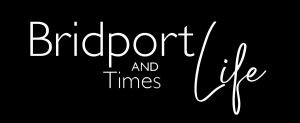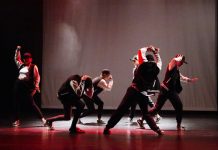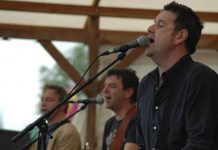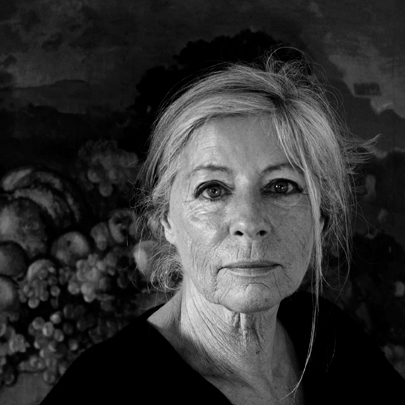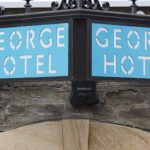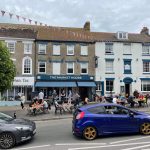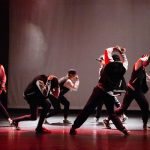‘I was born on the edge of The Lincolnshire Wolds on 2 January 1943, in a tiny village called Riby. Despite the intensity of the War at this time, our life was good and my memories of childhood are happy ones. I have two sisters, one older and one younger and a brother, ten years younger, born on Christmas Day! Life seemed to be an adventure for us all as we grew up together. We lived on a farm that had cattle and sheep and arable land too, we had cats, dogs, guinea pigs, chickens and ponies. There was plenty of freedom to explore the countryside around us. It was a wholesome, self-sufficient upbringing and my love of the natural landscape stems from this early part of my life. I attended a small primary school in the market town of Louth and am still in touch with some of my best friends from there. My secondary years were spent at a boarding school in the Lake District, many miles away from my parents’ farm but close to my Grandmother’s house, which had been a destination for childhood holidays and is now owned by my one of my sisters. For me there is a real sense of belonging associated with this part of the world.
In 1960 at the age of 17 I went to a finishing school in Sussex and came out with a hunger for life and a list of things that I didn’t want to do! My first taste of the vibrant and cultured life of the 60s came when I went to stay with my Aunt in central London. She was a buyer at Harrods and introduced me to the city. After plenty of negotiating and discussion with my parents, I moved to London and secured a job at Harrods. Within 3 months of moving to bustling London I was introduced to a top agent during a party at The Savoy. That was the beginning of my modelling career and the end of my Harrods job! Within a week of being with this agent I was taken on a tour of the British Isles with Norman Hartnell, dress designer to the Queen. On returning from the tour I saw some test shots that eminent fashion photographer, John Cowan, had taken of me some weeks before, there was much interest with jobs already lined up for me. At this point I changed my agent and started the next phase of my career. The first shoot was for the Daily Express fashion pages. I was to feature as a girl from the country, going to Ascot, Henley and Glyndebourne. It ran over several weeks and I enjoyed this type of work. It was the beginning of a huge change in the fashion scene as young photographers changed their approach to fashion shoots, instead of being 20 but trying to look 30 we were being 20 and trying to look 20! I worked with Mary Quant, who was instrumental in the design of the ‘Miniskirt’ with my hair done by the late Vidal Sasoon who was, at the time, revolutionary in his approach to hair styling. There was something about London then that was buzzing, the size of ‘the pool’ was a lot smaller than it is now, and the creativity of the young people was in an exciting new era. I started to work with some very dynamic photographers from New York and Paris. I was lucky that they wanted me as much as I wanted to be a part of that scene. The approach of these photographers and publications was exactly what I wanted. Over time I forged my own niche and although I always had an agent I was in total control of the work I was doing; the shoots often required me to travel to places as diverse as the Sahara Desert or the Arctic. Another major aspect to life at this time was the music, the scene was fantastic. I met Mick Jagger in the Vogue studios whilst doing a shoot with David Bailey, he strolled in and said hello, it was all very casual and relaxed. The Beatles would be at the same cocktail parties I went to, the people and the atmosphere were vast, the whole scene was brimming with vibrance. There was never a dull moment! In the mid 60s I played a small part in a movie by Michelangelo Antonioni called Blow Up, now a cult classic. The film is partly inspired by the life of David Bailey and was shot in John Cowan’s studio in the swinging sixties. In January 1968 I did some work in Paris and ended up staying there for a year! I had a flat in the Latin Quarter and witnessed the infamous student riots sometimes having to rush home from work so that I didn’t get caught by the tear gas. From Paris I moved to Italy, with my first husband, where we stayed for the next 9 years, I continued globetrotting for publications such as Vogue and Harpers Bazaar. I lived in Rome where I honed my appreciation of good food, loving trips to market to select fresh ingredients to cook with. On occasion I would be lucky enough to be given tightly guarded recipes, I was in my element! During those years I was very good friends with the director David Lean, (Lawrence Of Arabia, The Bridge On The River Kwai) and his wife Sandy. We went on several reconnaissance trips together to Polynesia and Africa and it was on one of these trips that I questioned whether it was time to slow down my work for the industry. In 1979 I went to stay in a friend’s apartment in the south of France where I lived for a couple of years. I did some occasional work with Helmut Newton who would sometimes be shooting in the area. It was not only the modelling that was coming to an end, I realized that it was time to end my marriage too. I came back to England and got divorced. It was 1982, I was about to turn 40 and a new chapter was beginning in my life. I decided to get away and so went to the Outer Hebrides to stay in my mother’s crofters cottage. For this trip I decided to buy a camera and try taking some photographs. I brought a Nikon FM2. Having seen the pros use this camera, I knew it would be a reliable bit of kit and tough. The landscape pictures I took on that holiday really blew me away and I knew this was the beginning of a new and important relationship between myself and the camera. I still shoot with that camera today. Later that year I showed the Scottish landscape photos I’d taken to some friends and they really loved them and wanted to buy prints from me. This greatly boosted my confidence and I knew that I had to carry on shooting. Another important relationship had begun too, with Richard Courtauld. I met Richie, who had a club in London, he had two wonderful children, Jamie and Chloe, from a previous marriage – they were 11 and 13. We married in 1984 and I became pregnant. Charlotte was born that year and Christabel came 3 years later. Having children was the most magical and immensely pleasing thing that has ever happened to me. In 1985 we went to stay on Long Island in New York at my sister’s place and it turned out that a great friend of Richie’s was working for Andy Warhol at The Factory, we were invited over for lunch one day and I took the camera with me. I asked Andy if I could take his picture, he said ‘yeah’ and so I asked him to sit in a chair I had spotted downstairs. It was a curious chair that looked slightly ominous. He sat in it with the studio dog and I captured what became one of my most popular shots. The Factory was, at this point very successful and productive. Andy had a Texan client with him who had commissioned a portrait in his iconic ‘Pop Art’ style and the place was buzzing with activity. It was not like the crazy, drug-fuelled party house that one might have imagined, given its previous reputation. I went on to take David Lean’s portrait and one thing led to another and the commissions started to roll in. I was very happy being the photographer and my work was proving to be successful. I am proud to say I now have 21 portraits hanging in the National Portrait Gallery. By this time we were missing the fresh air of the country and wanted to get out of the city. We decided to move. I wanted the kids to have the same rural upbringing that had been so instrumental to my positive outlook and appreciation of life. The move did mean that I severed some of my city contacts, but being back in the English countryside with my family was far more important to me. We eventually landed here in Whetley, a small settlement nestled below Eggardon Hill.I really love it here. I continue to take portrait commissions and enjoy photographing the landscape as it changes through the seasons.’

